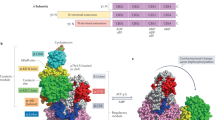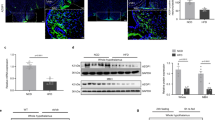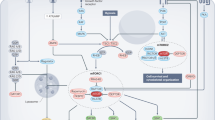Abstract
Since its discovery as an important regulator of fuel utilization in the periphery, AMP-activated protein kinase (AMPK) has become a contender for many important cell-intrinsic and organismal roles regarding energy balance in the central nervous system. The challenge will be to delineate the mechanisms by which neuronal AMPK can respond to cellular energy requirements as well as whole body energy demands. Thus, under physiological conditions in the brain, hypothalamic AMPK responds to changes in energy balance/food intake, whereas under pathological conditions, AMPK responds globally in the brain to energy challenge. Modulation of fatty acid metabolism affects energy balance in a context-specific manner and may provide an insight into other mechanisms for selective activation or inhibition of AMPK activity for therapeutic applications.
This is a preview of subscription content, access via your institution
Access options
Subscribe to this journal
Receive 12 print issues and online access
$259.00 per year
only $21.58 per issue
Buy this article
- Purchase on Springer Link
- Instant access to full article PDF
Prices may be subject to local taxes which are calculated during checkout
Similar content being viewed by others
References
Schwartz M, Woods S, Porte Jr D, Seeley R, Baskin D . Central nervous system control of food intake. Nature 2000; 404: 661–671.
Hardie DG, Carling D . The AMP-activated protein kinase—fuel gauge of the mammalian cell? Eur J Biochem 1997; 246: 259–273.
Kemp BE, Stapleton D, Campbell DJ, Chen ZP, Murthy S, Walter M et al. AMP-activated protein kinase, super metabolic regulator. Biochem Soc Trans 2003; 31: 162–168.
Kim EK, Miller I, Aja S, Landree LE, Pinn M, McFadden J et al. C75, a fatty acid synthase inhibitor, reduces food intake via hypothalamic AMP-activated protein kinase. J Biol Chem 2004; 279: 19970–19976.
Minokoshi Y, Alquier T, Furukawa N, Kim YB, Lee A, Xue B et al. AMP-kinase regulates food intake by responding to hormonal and nutrient signals in the hypothalamus. Nature 2004; 428: 569–574.
Andersson U, Filipsson K, Abbott CR, Woods A, Smith K, Bloom SR et al. AMP-activated protein kinase plays a role in the control of food intake. J Biol Chem 2004; 279: 12005–12008.
Kuhajda FP, Pizer ES, Li JN, Mani NS, Frehywot GL, Townsend CA . Synthesis and antitumor activity of an inhibitor of fatty acid synthase. Proc Natl Acad Sci USA 2000; 97: 3450–3454.
Landree LE, Hanlon AL, Strong DW, Rumbaugh G, Miller IM, Thupari JN et al. C75, a fatty acid synthase inhibitor, modulates AMP-activated protein kinase to alter neuronal energy metabolism. J Biol Chem 2004; 279: 3817–3827.
Thupari JN, Kim EK, Moran TH, Ronnett GV, Kuhajda FP . Chronic C75 treatment of diet-induced obese mice increases fat oxidation and reduces food intake to reduce adipose mass. Am J Physiol Endocrinol Metab 2004; 287: E97–E104.
Thupari JN, Landree LE, Ronnett GV, Kuhajda FP . C75 increases peripheral energy utilization and fatty acid oxidation in diet-induced obesity. Proc Natl Acad Sci USA 2002; 99: 9498–9502.
McCullough LD, Zeng Z, Li H, Landree LE, McFadden J, Ronnett GV . Pharmacological inhibition of AMP-activated protein kinase provides neuroprotection in stroke. J Biol Chem 2005; 280: 20493–20502.
Chirala SS, Huang WY, Jayakumar A, Sakai K, Wakil SJ . Animal fatty acid synthase: functional mapping and cloning and expression of the domain I constituent activities. Proc Natl Acad Sci USA 1997; 94: 5588–5593.
Wakil S . Fatty acid synthase, a proficient multifunctional enzyme. Biochemistry 1989; 28: 4523–4530.
Wakil SJ, Stoops JK, Joshi VC . Fatty acid synthesis and its regulation. Annu Rev Biochem 1983; 52: 537–579.
Dyck JR, Berthiaume LG, Thomas PD, Kantor PF, Barr AJ, Barr R et al. Characterization of rat liver malonyl-CoA decarboxylase and the study of its role in regulating fatty acid metabolism. Biochem J 2000; 350 (Part 2): 599–608.
Kim KH . Regulation of mammalian acetyl-coenzyme A carboxylase. Annu Rev Nutr 1997; 17: 77–99.
Lopez-Casillas F, Ponce-Castaneda MV, Kim KH . In vivo regulation of the activity of the two promoters of the rat acetyl coenzyme-A carboxylase gene. Endocrinology 1991; 129: 1049–1058.
Goodridge AG . Regulation of the activity of acetyl-coenzyme A carboxylase by palmitoyl-coenzyme A and citrate. J Biol Chem 1972; 247: 6946–6952.
Abu-Elhiega L, Almarza-Ortega D, Baldini A, Wakil S . Human acetyl-coA carboxylase 2. Molecular cloning, characterization, chromosomal mapping, and evidence for two isoforms. J Biol Chem 1997; 272: 10669–10677.
Eaton S, Bartlett K, Quant PA . Carnitine palmitoyl transferase I and the control of beta-oxidation in heart mitochondria. Biochem Biophys Res Commun 2001; 285: 537–539.
McGarry JD, Foster DW . Regulation of hepatic fatty acid oxidation and ketone body production. Annu Rev Biochem 1980; 49: 395–420.
Cook GA, Edwards TL, Jansen MS, Bahouth SW, Wilcox HG, Park EA . Differential regulation of carnitine palmitoyltransferase-I gene isoforms (CPT-I alpha and CPT-I beta) in the rat heart. J Mol Cell Cardiol 2001; 33: 317–329.
Park EA, Steffen ML, Song S, Park VM, Cook GA . Cloning and characterization of the promoter for the liver isoform of the rat carnitine palmitoyltransferase I (L-CPT I) gene. Biochem J 1998; 330 (Part 1): 217–224.
Yamazaki N, Yamanaka Y, Hashimoto Y, Shinohara Y, Shima A, Terada H . Structural features of the gene encoding human muscle type carnitine palmitoyltransferase I. FEBS Lett 1997; 409: 401–406.
Price N, van der Leij F, Jackson V, Corstorphine C, Thomson R, Sorensen A et al. A novel brain-expressed protein related to carnitine palmitoyltransferase I. Genomics 2002; 80: 433–442.
Loftus TM, Jaworsky DE, Frehywot GL, Townsend CA, Ronnett GV, Lane MD et al. Reduced food intake and body weight in mice treated with fatty acid synthase inhibitors. Science 2000; 288: 2379–2381.
Mitchelhill KI, Stapleton D, Gao G, House C, Michell B, Katsis F et al. Mammalian AMP-activated protein kinase shares structural and functional homology with the catalytic domain of yeast Snf1 protein kinase. J Biol Chem 1994; 269: 2361–2364.
Stapleton D, Mitchelhill KI, Gao G, Widmer J, Michell BJ, Teh T et al. Mammalian AMP-activated protein kinase subfamily. J Biol Chem 1996; 271: 611–614.
Stapleton D, Woollatt E, Mitchelhill KI, Nicholl JK, Fernandez CS, Michell BJ et al. AMP-activated protein kinase isoenzyme family: subunit structure and chromosomal location. FEBS Lett 1997; 409: 452–456.
Cheung PC, Salt IP, Davies SP, Hardie DG, Carling D . Characterization of AMP-activated protein kinase gamma-subunit isoforms and their role in AMP binding. Biochem J 2000; 346 (Part 3): 659–669.
Kahn BB, Alquier T, Carling D, Hardie DG . AMP-activated protein kinase: ancient energy gauge provides clues to modern understanding of metabolism. Cell Metab 2005; 1: 15–25.
Merrill GF, Kurth EJ, Hardie DG, Winder WW . AICA riboside increases AMP-activated protein kinase, fatty acid oxidation, and glucose uptake in rat muscle. Am J Physiol 1997; 273: E1107–E1112.
Kurth-Kraczek EJ, Hirshman MF, Goodyear LJ, Winder WW . 5′ AMP-activated protein kinase activation causes GLUT4 translocation in skeletal muscle. Diabetes 1999; 48: 1667–1671.
Leff T . AMP-activated protein kinase regulates gene expression by direct phosphorylation of nuclear proteins. Biochem Soc Trans 2003; 31: 224–227.
Hardie DG . New roles for the LKB1 → AMPK pathway. Curr Opin Cell Biol 2005; 17: 167–173.
Minokoshi Y, Kim YB, Peroni OD, Fryer LG, Müller C, Carling D et al. Leptin stimulates fatty-acid oxidation by activating AMP-activated protein kinase. Nature 2002; 415: 339–343.
Yamauchi T, Kamon J, Minokoshi Y, Ito Y, Waki H, Uchida S et al. Adiponectin stimulates glucose utilization and fatty-acid oxidation by activating AMP-activated protein kinase. Nat Med 2002; 8: 1288–1295.
Marsin AS, Bouzin C, Bertrand L, Hue L . The stimulation of glycolysis by hypoxia in activated monocytes is mediated by AMP-activated protein kinase and inducible 6-phosphofructo-2-kinase. J Biol Chem 2002; 277: 30778–30783.
Carling D, Zammit VA, Hardie DG . A common bicyclic protein kinase cascade inactivates the regulatory enzymes of fatty acid and cholesterol biosynthesis. FEBS Lett 1987; 223: 217–222.
Gao S, Lane MD . Effect of the anorectic fatty acid synthase inhibitor C75 on neuronal activity in the hypothalamus and brainstem. Proc Natl Acad Sci USA 2003; 100: 5628–5633.
Hu Z, Cha SH, van Haasteren G, Wang J, Lane MD . Effect of centrally administered C75, a fatty acid synthase inhibitor, on ghrelin secretion and its downstream effects. Proc Natl Acad Sci USA 2005; 102: 3972–3977.
Clegg DJ, Wortman MD, Benoit SC, McOsker CC, Seeley RJ . Comparison of central and peripheral administration of C75 on food intake, body weight, and conditioned taste aversion. Diabetes 2002; 51: 3196–3201.
Takahashi KA, Smart JL, Liu H, Cone RD . The anorexigenic fatty acid synthase inhibitor, C75, is a nonspecific neuronal activator. Endocrinology 2004; 145: 184–193.
Kim EK, Miller I, Landree LE, Borisy-Rudin FF, Brown P, Tihan T et al. Expression of FAS within hypothalamic neurons: a model for decreased food intake after C75 treatment. Am J Physiol Endocrinol Metab 2002; 283: E867–E879.
Miller I, Ronnett GV, Moran TH, Aja S . Anorexigenic C75 alters c-Fos in mouse hypothalamic and hindbrain subnuclei. NeuroReport 2004; 15: 925–929.
Cha SH, Hu Z, Lane MD . Long-term effects of a fatty acid synthase inhibitor on obese mice: food intake, hypothalamic neuropeptides, and UCP3. Biochem Biophys Res Commun 2004; 317: 301–308.
Shimokawa T, Kumar MV, Lane MD . Effect of a fatty acid synthase inhibitor on food intake and expression of hypothalamic neuropeptides. Proc Natl Acad Sci USA 2002; 99: 66–71.
Giraudo SQ, Billington CJ, Levine AS . Feeding effects of hypothalamic injection of melanocortin 4 receptor ligands. Brain Res 1998; 809: 302–306.
Bloch B, Bugnon C, Fellmann D, Lenys D, Gouget A . Neurons of the rat hypothalamus reactive with antisera against endorphins, ACTH, MSH and beta-LPH. Cell Tissue Res 1979; 204: 1–15.
Fan W, Boston BA, Kesterson RA, Hruby VJ, Cone RD . Role of melanocortinergic neurons in feeding and the agouti obesity syndrome. Nature 1997; 385: 165–168.
Hagan MM, Rushing PA, Schwartz MW, Yagaloff KA, Burn P, Woods SC et al. Role of the CNS melanocortin system in the response to overfeeding. J Neurosci 1999; 19: 2362–2367.
Clark JT, Kalra PS, Crowley WR, Kalra SP . Neuropeptide Y and human pancreatic polypeptide stimulate feeding behavior in rats. Endocrinology 1984; 115: 427–429.
Hahn TM, Breininger JF, Baskin DG, Schwartz MW . Coexpression of Agrp and NPY in fasting-activated hypothalamic neurons. Nat Neurosci 1998; 1: 271–272.
Havel PJ, Hahn TM, Sindelar DK, Baskin DG, Dallman MF, Weigle DS et al. Effects of streptozotocin-induced diabetes and insulin treatment on the hypothalamic melanocortin system and muscle uncoupling protein 3 expression in rats. Diabetes 2000; 49: 244–252.
Widdowson PS, Henderson L, Pickavance L, Buckingham R, Tadayyon M, Arch JR et al. Hypothalamic NPY status during positive energy balance and the effects of the NPY antagonist, BW 1229U91, on the consumption of highly palatable energy-rich diet. Peptides 1999; 20: 367–372.
Nambu T, Sakurai T, Mizukami K, Hosova Y, Yanagisawa M, Goto K . Distribution of orexin neurons in the adult rat brain. Brain Res 1999; 827: 243–260.
Qu D, Ludwig DS, Gammeltoft S, Piper M, Pelleymounter MA, Cullen MJ et al. A role for melanin-concentrating hormone in the central regulation of feeding behaviour. Nature 1996; 380: 243–247.
Miselis RR . The subfornical organ's neural connections and their role in water balance. Peptides 1982; 3: 501–502.
Chronwall BM, DiMaggio DA, Massari VJ, Pickel VM, Ruggiero DA, O'Donohue TL . The anatomy of neuropeptide-Y-containing neurons in rat brain. Neuroscience 1985; 15: 1159–1181.
Arletti R, Benelli A, Bertolini A . Influence of oxytocin on feeding behavior in the rat. Peptides 1989; 10: 89–93.
Uht RM, McKelvy JF, Harrison RW, Bohn MC . Demonstration of glucocorticoid receptor-like immunoreactivity in glucocorticoid-sensitive vasopressin and corticotropin-releasing factor neurons in the hypothalamic paraventricular nucleus. J Neurosci Res 1988; 19: 405–411, 468–469.
Ceccatelli S, Cintra A, Hokfelt T, Fuxe K, Wikstrom AC, Gustafsson JA . Coexistence of glucocorticoid receptor-like immunoreactivity with neuropeptides in the hypothalamic paraventricular nucleus. Exp Brain Res 1989; 78: 33–42.
Yang SY, He XY, Schulz H . Fatty acid oxidation in rat brain is limited by the low activity of 3-ketoacyl-coenzyme A thiolase. J Biol Chem 1987; 27: 13027–13032.
Carling D . The AMP-activated protein kinase cascade—a unifying system for energy control. Trends Biochem Sci 2004; 29: 18–24.
Makimura H, Mizuno TM, Yang XJ, Silverstein J, Beasley J, Mobbs CV . Cerulenin mimics effects of leptin on metabolic rate, food intake, and body weight independent of the melanocortin system, but unlike leptin, cerulenin fails to block neuroendocrine effects of fasting. Diabetes 2001; 50: 733–739.
Gilbert M, Magnan C, Turban S, Andre J, Guerre-Millo M . Leptin receptor-deficient obese Zucker rats reduce their food intake in response to a systemic supply of calories from glucose. Diabetes 2003; 52: 277–282.
Musi N, Goodyear LJ . Targeting the AMP-activated protein kinase for the treatment of type 2 diabetes. Curr Drug Targets Immune Endocr Metabol Disord 2002; 2: 119–127.
Sabina RL, Patterson D, Holmes EW . 5-Amino-4-imidazolecarboxamide riboside (Z-riboside) metabolism in eukaryotic cells. J Biol Chem 1985; 260: 6107–6114.
Sheriff S, Chance WT, Fischer JE, Balasubramaniam A . Neuropeptide Y treatment and food deprivation increase cyclic AMP response element-binding in rat hypothalamus. Mol Pharmacol 1997; 51: 597–604.
Love S . Apoptosis and brain ischaemia. Prog Neuropsychopharmacol Biol Psychiatry 2003; 27: 267–282.
Ha HC, Snyder SH . Poly(ADP-ribose) polymerase-1 in the nervous system. Neurobiol Dis 2000; 7: 225–239.
Du L, Zhang X, Han YY, Burke NA, Kochanek PM, Watkins SC et al. Intra-mitochondrial poly(ADP-ribosylation) contributes to NAD+ depletion and cell death induced by oxidative stress. J Biol Chem 2003; 278: 18426–18433.
Author information
Authors and Affiliations
Corresponding author
Additional information
Conflict of interest
GV Ronnett is a consultant and stock holder for FASgen. GV Ronnett's work with FASgen does not directly involve AMPK. S Aja has declared no financial interests.
Rights and permissions
About this article
Cite this article
Ronnett, G., Aja, S. AMP-activated protein kinase in the brain. Int J Obes 32 (Suppl 4), S42–S48 (2008). https://doi.org/10.1038/ijo.2008.122
Published:
Issue Date:
DOI: https://doi.org/10.1038/ijo.2008.122



